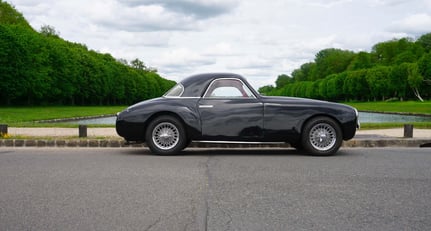-
Year of manufacture1950
-
Car typeCoupé
-
Lot number62
-
ConditionUsed
-
Interior colourRed
-
Location

-
Exterior colourBlack
Description
Serial number 885224
Facel Metallon bodywork
Design by Stabilimenti Farina - French registration
A French subsidiary of Fiat at the end of the 1930s, SIMCA quickly became one of the main players in the French market for small popular cars before the Second World War. Although the war put an end to SIMCA's production, the company's engineers brought out models produced up to 1939 in order to relaunch the brand's economy, but with much greater difficulty, as the competition was tough against Renault, which had just been nationalised, and which allowed itself the luxury of using a large part of the steel and which made a real hit with its 4CV. Henri Théodore Pigozzi, director of the firm, then took the gamble of going upmarket and stopping his fight in the popular car ring by proposing the SIMCA 8 at the end of the 1940s with a radically different design compared to the rest of the brand's catalogue.
Presented in 1948, the 8 Sport was an alliance of several automobile manufacturers to create the most beautiful French car of the time. Its very Italian design was entrusted to Stabilimenti Farina, a close relative of Pinin Farina, which recalls the desirable Ferrari or Maserati coupes of the 1950s. Production was carried out by Facel-Métallon and FIAT. In total, just over 5,000 coupés and cabriolets were produced until 1952 when it was replaced by the more powerful SIMCA 9 Sport.
The engine of the 8 is based on the Aronde's block with its small 4-cylinder 1.1 litre engine that develops 50 horsepower and propels the car to a maximum speed of 135 km/h. Whatever one may say, the 8 Sport is only "sporty" in name and is more of a top-of-the-range and very elegant car of which the history of the French Automobile can be proud.
The SIMCA 8 Sport we present to you was delivered in France in 1950 in its coupé bodywork. Today, the car is painted in black with a few small flaws, but it looks quite good and this colour emphasizes the round lines of the little Franco-Italian coupe. After lifting the flush chrome door handle on the driver's side, we enter a plush interior with red leather upholstery and a painted dashboard that matches the seats. The necessary information is there: speedometer and rev counter, a clock and various bakelite buttons complete the car's few features. A 4-speed manual gearbox is located under the dashboard and takes some getting used to, as the position of the lever is not obvious. Mechanically, the engine of our example runs well; the engine is neither pushy nor fast but develops an interesting sound and promises a nice ride around 80 km/h.
The exterior is quite weathered and the car is mounted on wire wheels which accentuates the resemblance with its transalpine counterparts.
This is a great opportunity to get back behind the wheel of the most desirable French car of the post-war period and probably still today, a great way to drive differently and elegantly.





















